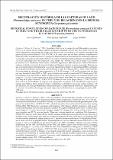Por favor, use este identificador para citar o enlazar este ítem:
https://hdl.handle.net/20.500.12958/3605Registro completo de metadatos
| Campo DC | Valor | Lengua/Idioma |
|---|---|---|
| dc.contributor.author | Quiñones, Javier | - |
| dc.contributor.author | Quispe Cayhualla, Sixto | - |
| dc.contributor.author | Zeballos, Jorge | - |
| dc.date.accessioned | 2021-10-19T23:00:51Z | - |
| dc.date.available | 2021-10-19T23:00:51Z | - |
| dc.date.issued | 2021-07 | - |
| dc.identifier.citation | Quiñones J, Quispe S, Zeballos J. 2021. Recopilación histórica de las captura de laúd(Dermochelys coriacea) en Perú y su relación con la medusa Scyphozoa Chrysaora plocamia. Bol Inst Mar Perú. 36(1): 140-155 | es_ES |
| dc.identifier.issn | 04587766 | - |
| dc.identifier.uri | https://hdl.handle.net/20.500.12958/3605 | - |
| dc.description.abstract | Se realizó seguimiento de capturas de tortuga laúd (Dermochelys coriacea) por la flota agallera tortuguera del puerto de San Andrés-Pisco (13°45’S, 76°13’W) en la costa centro sur del Perú, durante el fenómeno El Niño (EN) 1987. Se analizó biometría, necropsias, determinación de abundancias de medusas Scyphozoa y encuestas a pescadores artesanales de Pisco. Se registró 34 tortugas laúd capturadas con talla promedio 117,3 ±10,2 cm Largo Curvo de Caparazón (LCC) (rango: 100 - 140 cm, n=22), de las cuales 77,3% fueron juveniles y 22,7% subadultos. Existe fuerte correlación significativa (Rho Spearman = 0,883 al 99%) entre capturas de laúd y presencia de medusa Scyphozoa Chrysaora plocamia a escalas mensuales. Durante ese año se presentó mayor abundancia de C. plocamia, registrándose hasta 12,4 kg medusa/1000m3, promedio 4,4 ±4 kg medusa/1000m3, usando una serie de tiempo de más de 4 décadas (1972 - 2014). Como resultado de las encuestas se calculó la captura promedio de 15,9 ±13,4 (rango: 2 - 40, n=17) tortugas laúd por bote por mes, durante los años 1970’s y 1980’s, proyectándose una tasa de extracción de 572,4 laudes para 1987. Sin embargo, en los años 1990’s y 2000’s las capturas fueron 55 veces menores, con promedio de 0,29 ± 0,5 (rango: 0 - 1,5, n=21). La principal zona de pesca de laúd en los años 1980’s fue una zona continua costera (~40 km) de la playa Caucato (13°38’S, 76°12’W) hasta el norte de la playa Jahuay (13°19’S, 76°14’W) de 6 a 20 m de profundidad. Se propone una segregación ontogénica en la distribución espacial de la tortuga laúd frente a Perú, donde juveniles y subadultos se distribuyen en zonas costero neríticas, <30 mn distancia a la costa, probablemente influenciadas por la disponibilidad alimentaria representada por C. plocamia. Los adultos de tortuga laúd están mayormente distribuidos en zona pelágico oceánica (300 - 1500 mn) | es_ES |
| dc.description.abstract | ABSTRACT: We monitored leatherback sea turtle (Dermochelys coriacea) catches made by the turtle gillnetting fleet in the port of San Andrés, Pisco (13°45’S, 76°13’W), which is located on the south-central Peruvian coast, during El Niño (EN) 1987. Biometrics, necropsies, determination of Scyphozoa jellyfish abundance, and surveys of artisanal fishermen of Pisco were analyzed. A total of 34 caught leatherback turtles were recorded with a mean length of 117.3 ±10.2 cm Curved Carapace Length (CCL) (range: 100 - 140 cm, n=22), of which 77.3% were juveniles and 22.7% were sub-adults. There was a strong significant correlation (Rho Spearman = 0.883 at 99%) between leatherback catches and the presence of the scyphozoan jellyfish Chrysaora plocamia at monthly scales. When using a time series covering more than four decades (1972-2014), we found that 1987 was the year that presented a higher abundance of C. plocamia, being recorded up to 12.4 kg jellyfish/1000m3, and a mean of 4.4 ± 4 kg jellyfish/1000m3. Regarding the surveys, we obtained a mean catch of 15.9 ± 13.4 (range: 2 - 40, n=17) leatherbacks per boat/ month in the 1970s and 1980s, with the extraction of 572.4 leatherbacks for EN 1987. Nevertheless, in the 1990’s and 2000’s, catches were 55 times lower, averaging 0.29 ± 0.5 (range: 0 - 1.5, n=21). In the 1980s the main area of leatherback fishing was a continuous coastal area (~40 km) from Caucato beach (13°38’S, 76°12’W) to the north of Jahuay beach (13°19’S, 76°14’W) at a depth between 6 and 20 m. Finally, we proposed ontogenetic spatial segregation, where juveniles and sub-adults are distributed in coastal-neritic areas, <30 nm offshore, probably influenced by coastal prey availability represented by C. plocamia. Conversely, adult leatherbacks are probably more distributed in oceanic pelagic waters (300 – 1500 nm offshore) | - |
| dc.language.iso | spa | es_ES |
| dc.publisher | INSTITUTO DEL MAR DEL PERÚ | es_ES |
| dc.relation.ispartofseries | Boletín IMARPE 36(1), 2021; | - |
| dc.rights | info:eu-repo/semantics/openAccess | es_ES |
| dc.rights.uri | https://creativecommons.org/licenses/by/4.0/ | es_ES |
| dc.source | Instituto del Mar del Perú - IMARPE | es_ES |
| dc.source.uri | Repositorio Digital IMARPE | es_ES |
| dc.subject | Dermochelys coriacea | es_ES |
| dc.subject | Chrysaora plocamia | es_ES |
| dc.title | Recopilación histórica de las captura de laúd(Dermochelys coriacea) en Perú y su relación con la medusa Scyphozoa Chrysaora plocamia | es_ES |
| dc.title.alternative | Historical compilation of leatherback (Dermochelys coriacea) catches in Peru and their relationship with the Scyphozoan jellyfish Chrysaora plocamia | es_ES |
| dc.type | info:eu-repo/semantics/article | es_ES |
| dc.publisher.country | Perú - Callao | es_ES |
| dc.subject.ocde | http://purl.org/pe-repo/ocde/ford#1.06.12 | es_ES |
| Aparece en las colecciones: | Boletín 36(1), 2021 | |
Ficheros en este ítem:
| Fichero | Descripción | Tamaño | Formato | |
|---|---|---|---|---|
| Boletin 36-1 articulo9.pdf | 1,49 MB | Adobe PDF |  Visualizar/Abrir |
Este ítem está sujeto a una licencia Creative Commons Licencia Creative Commons

